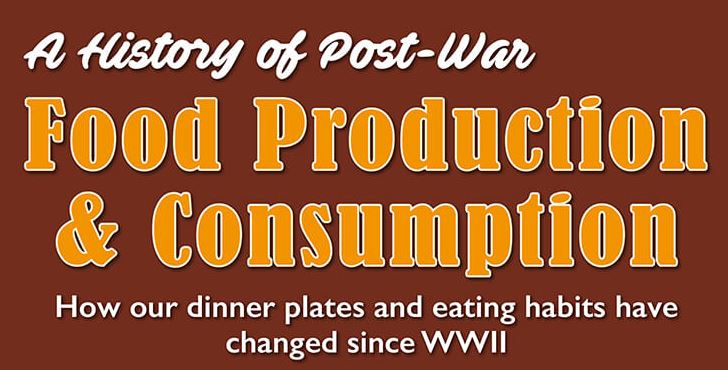How have our eating habits changed since WWII?
Monday, September 25, 2017 - 11:14

The production and consumption of food in the UK has changed drastically in the decades following World War II in 1945. When we shop now, we are faced with many choices – a luxury that hasn’t always been available.
The rationing days were over from 1954, and a food and restaurant revolution soon began. Disposable income began to rise and going out for food became a popular leisure activity.
The way that food was stored and prepared changed too – technological advances led to fridges, freezers and microwave ovens in homes. Travel to and from other countries has become easier too and hospitality has become a huge industry in the UK – heightening the standards of restaurants further.
1940s
During the 1940s, eating habits were dominated by the war and the government’s attempts to ensure a balanced diet was available to everyone. To ensure that the population were receiving an equal amount of the limited food available, rationing was introduced. This led to a lower consumption of meat, fat, eggs and sugar.
1950s
The 1950s have been referred to as the most austere decade in the past 70 years due to rationing and a lack of eating out. Chickens were reared for the first time throughout this decade, and Bird’s Eye introduced the fish finger by using blast freezing technology. A huge 40% of total household income was spent on food – a figure that fell to 10.7% by 2016.
1960s
Throughout the next decade of the 1960s, globalisation played a key part in the way that Britain produced and consumed food. New culinary trends became popular as immigration increased, and Indian, Pakistani and Chinese communities introduced new dishes. As aeroplane travel became cheaper, exotic tastes from various parts of Europe were brought back into British homes. Food preparation and storage improved and 33% of households owned a fridge by 1962.
1970s
Classic English restaurants, decorated with high beams inspired by the Tudors, became popular in the 1970s. Restaurant chain Berni Inn had 170 outlets, and Beefeater and Brewers Fayre soon followed. Fast food giant, McDonalds, opened its doors in 1974 and now has 1291 across the UK.
1980s
As the 1980s progressed, demand for convenience foods increased and eating out was dominated by the need for fast food. Takeaways started to increase in popularity within families as Pizza Hut launched their first UK outlet in 1982 – the UK takeaway industry is now estimated to be worth £4.5 billion. Andrew Nisbet started a business selling knives, clothing and text books to catering students. After strong growth over 34 years, they have become specialists in catering equipment and serving the needs of their customers.
1990s
1990s saw the rise of ‘Gastropubs’, following the opening of the first one in Farringdon, London called The Eagle. Other chains of bars recognised the attraction of selling food as part of their offering and jumped on the bandwagon. The trend of coffee shops exploded, they grew in the UK at a rate of 847% between 1993 and 1997. Now, over 70 million cups of coffee are consumed per day in the UK. A big hit to the agriculture industry in the 1990s was Mad Cow Disease – agriculture minister, John Gummer, fed his daughter a burger on TV to restore public confidence in meat.
2000s
The acceptance of international flavours was confirmed in the 2000s as chicken tikka masala was named as the national restaurant dish of the year. New health recommendations were introduced in 2003 as the government released the guidelines of 5 portions of fruit and vegetables a day – restaurants noticed this trend and started to introduce healthier menus. Following the credit crunch, organic food sales have dropped by 13% since 2008 – before this organic food had been on the up since 1993.
2010s
As we near the end of the 2010s, the hospitality industry is ranked as the fourth largest in the UK – demonstrating the rise of eating out in restaurants and bars. An outstanding £52,200,000,000 was how much British people spent on eating out in 2015 and this is forecasted to rise further. Ethics has come to play a huge part in consumer food choices as consumers prefer purchasing ‘food with a story’. With the vote to leave the EU in 2016, impacts on the food and restaurant markets are unknown. Price changes in food are due to be discussed before Brexit is finalised in 2019.
Download the infographic here
Guest blog from: Nisbets www.nisbets.co.uk
 cy
cy


